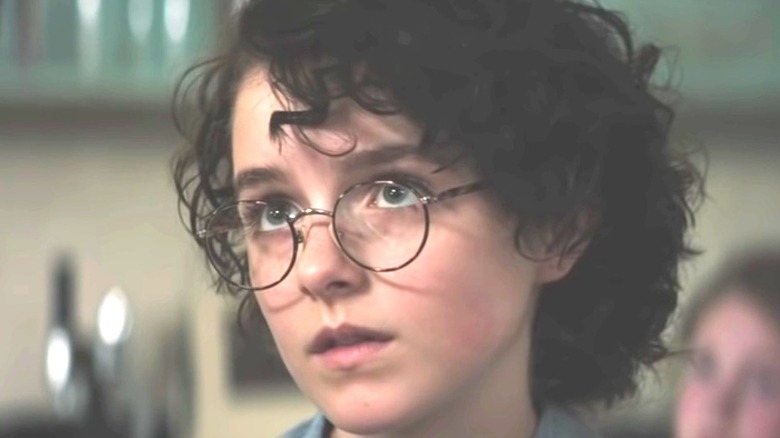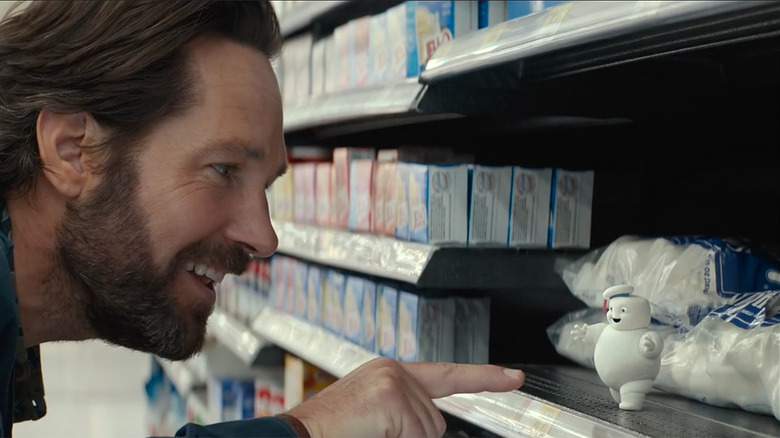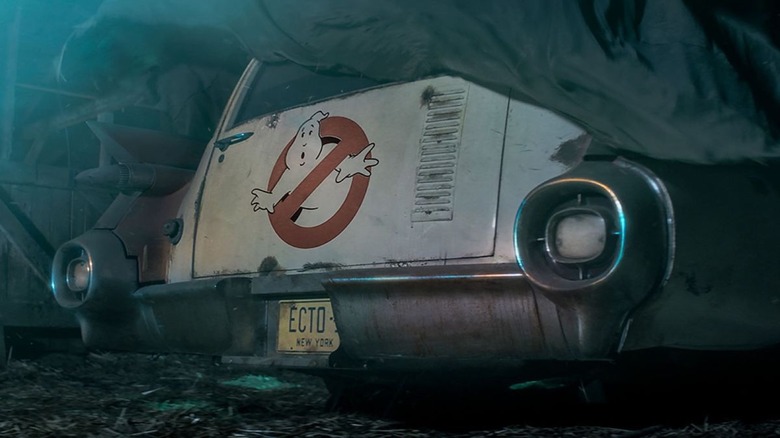Ghostbusters: Afterlife Review: Chasing Ghosts
When you're in the mood for the ideal combination of hauntings and humor, ghouls and guffaws, laughter and large marshmallow men, who ya gonna call? Since 1984, the best answer to that question has been "Ghostbusters," because every film that has tried to step into its jumpsuit and proton pack since — including not only 1989's "Ghostbusters II" and Paul Feig's 2016 female-led "Ghostbusters," but also Ivan Reitman's 2001 clunker "Evolution" and every other wannabe from "Pixels" to "RIPD" — has come up short. Now comes the latest contender, "Ghostbusters: Afterlife," another film that ultimately doesn't deserve to be in the same conversation — but nonetheless feels as close as Hollywood could realistically get to capturing this particular lightning in a bottle again.
Since the early '90s, "Ghostbusters" has occupied the holy tetralogy of once-great Intellectual Property damned by its success to be beaten into the ground beyond any recognition of their once-promising origins. Heaped into a pile alongside the "Aliens," "Predator" and "Terminator" franchises, these series will continue to be rebooted, revisited, "taken back to roots" and pass torches to "a new generation" long after we're all dead and buried.
Out of all the post-1991 media produced from these four franchises, "Afterlife" might just be the best. Faint praise, sure — but if you're looking for a breezy flick to catch with the family, you could do worse than this "'Ghostbusters' by way of 'Stranger Things'" popcorn flick.
"Afterlife" opens with a shadowy, silent figure — who is clearly some sort of returned-to-life Harold Ramis (the actor/filmmaker died in 2014) battling a ghost one last time before succumbing to its attack. A few scenes later, his estranged daughter Callie (Carrie Coon) and her brainy, awkward kids Trevor (Finn Wolfhard) and Phoebe (Mckenna Grace) relocate to Summerville, Oklahoma to pick over what's left of the "estate": a dilapidated, spray-painted dirt farm, odd stacks of books, and a mountain of debt. But Callie has no better options, so she stays in the town, hoping for a new chapter.
Boy, does her family get one. Phoebe bonds with local summer school teacher/seismologist/heartthrob Gary Grooberson (a charming Paul Rudd), while Trevor falls for local burger babe Lucky (Celeste O'Connor). Also tagging along for the adventure is "Podcast" (Logan Kim), the latest example of a rapidly-tiring trend of movies making young people podcast hosts so they can narrate exposition to their "listeners" (see David Gordon Green's "Halloween" and "Godzilla vs. Kong" for two recent examples) and make jokes about how nobody actually listens to their podcasts. All these characters come together in a small, forgotten town where earthquakes happen every day — although there seems to be no natural explanation. Could it be ... supernatural?
Of course, Trevor and Phoebe are actually the grandchildren of Egon Spengler (Ramis). Which means that there are ghost-hunting materials all over the property — and as Phoebe learns when she begins playing chess with an invisible opponent, Grandpa has lessons to teach them from the great beyond. What follows is a slow-peeling onion that isn't so much a mystery as it is a recitation of ritual, one where viewers will most likely know the destination in every frame, but won't care as long as it eventually gets where it needs to — namely, bringing back the fab four.
This wasn't on the shopping list
For people under a certain age, perhaps this conceit will work just fine in teaching them why the grownups still care about this movie nearly 40 years later. All the young actors are solid, with 15-year-old Mckenna Grace being the standout who takes her role to the next level — a la Samara Weaving and Bigette Lundy-Paine in last year's "Bill & Ted Face the Music," she simultaneously channels a classic character while creating a new one, in a skilled performance that could have been unbearably cloying in lesser hands. But ask yourself: Could this storyline stand independently if you take away the 1984 "Ghostbusters" cane on which it so heavily leans? The answer, unfortunately, is no.
But that money moment does eventually arrive when the original gang — Bill Murray as Venkman, Dan Aykroyd as Stantz, Ernie Hudson as Winston and (kinda sorta) Harold Ramis as Egon — stand side by side, trying once again to not cross their streams as they fire upon Gozer, who has chosen Summerville as the source of a new uprising attempt. The moment reminds you that Bill Murray has still got it (his handful of lines are funnier and ooze more charisma than anything else in the movie), and that the four men clicked on a level that simply can't be replicated — for a brief moment, it will make you feel like you're ten years old again.
At the end of the day, perhaps that's all we need out of "Ghostbusters: Afterlife." Writer/director Jason Reitman has forged a solid, Oscar-nominated career of his own via films like "Juno" and "Up in the Air," but he may never have had those opportunities had it not been for his father Ivan, and Ivan Reitman would have had a very different career if not for "Ghostbusters." Because of that, both men clearly have a love for the franchise and a desire to please the fanbase (the elder Reitman serves on "Afterlife" as a producer, and was reportedly on set nearly every day), and there is a family vibe in this movie that almost even makes the Harold Ramis thing forgivable. Well, almost.
Out-of-state plates
More than two decades after Fred Astaire danced with a vacuum, and on the heels of the latest "performances" from Carrie Fisher, Peter Cushing and Donald Pleasence, it remains both fascinating and inherently creepy when Hollywood attempts to resurrect a dead actor for a new film. Like witnessing a car accident, it floods the viewer with emotion, but you can't look away. In "Afterlife," Ramis is very much a featured actor, from his shadowy opening scene to his full-on spectral appearance at the end of the film. Although he never speaks, Egon's grafted-together expressions gaze lovingly upon his granddaughter and old buddies, "acting" in whatever ways the person behind the computer chose to impose on the man who died several years before this film's script was even written.
Are we being manipulated? Absolutely. Is this any different than when a filmmaker uses CG to create an endearing alien or talking animal sidekick out of pixels and thin air rather than a Harold Ramis? That's debatable. But, how much you but into the film's "we're family" vibe and a "For Harold" dedication at the end making the proceedings a tribute rather than a transparent gimmick will dictate how effective such scenes are for you.
As will the relentless onslaught of Easter eggs. Honestly, it's amazing that the new actors can get any sort of traction in "Afterlife," because almost every scene has them contending with a stack of books, loaded lines like "There is no mom, there's only Zuul" or a quick sighting of the colander helmet Rick Moranis wore in the '80s. Depending on your affection for such things — and ability to spot them without being distracted from what the actors are trying to do in the scene itself — you might get a thrill from seeing the Ecto-1 in action again, an Annie Potts cameo, or tiny Stay-Puft marshmallow men, and it will all feel worthwhile.
Taken as a whole, "Afterlife" is an exercise in chasing ghosts that underlines a reality Hollywood would love us all to ignore: Movies like "Ghostbusters," "Predator" and the first two "Alien" and "Terminator" films caught the right people at the right time. Those people, at those points in their career, are inextricable from what made those films great. Names like Murray, Schwarzenegger, Ridley Scott, James Cameron, Sigourney Weaver and more — all Hollywood legends, all at the height of their power.
Try as they might, and no matter how much films like "Afterlife" hope to push an "Anybody can be a Ghostbuster" message, CG artists can never recapture that lightning-in-a-bottle magic. When all is said and done, personality is Hollywood's most underrated special effect.


